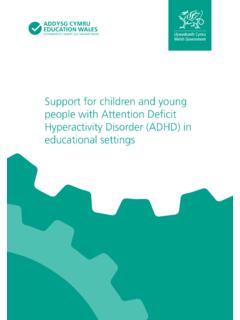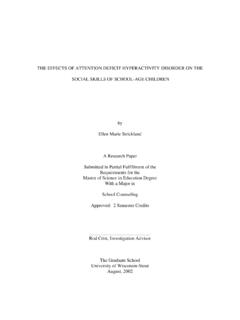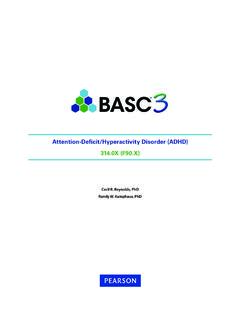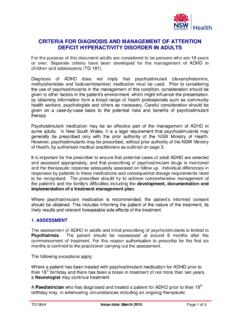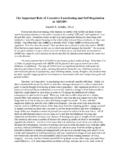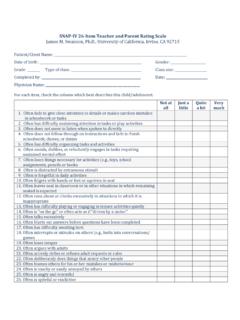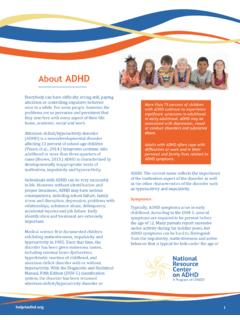Transcription of TEACHING CHILDREN WITH ATTENTION DEFICIT …
1 TEACHING CHILDREN with ATTENTION DEFICIT hyperactivity DISORDER: INSTRUCTIONAL STRATEGIES AND PRACTICES 2006 TEACHING CHILDREN with ATTENTION DEFICIT hyperactivity Disorder: Instructional Strategies and Practices 2006 This report was produced under Department of Education Contract No. HS97017002 with the American Institutes for Research. Kelly Henderson served as technical representative for this project. Department of Education Margaret Spellings Secretary Office of Special Education and Rehabilitative Services John H. Hager Assistant Secretary Office of Special Education Programs Alexa Posny Acting Director Research to Practice Division Louis Danielson Director First printed: February 2004 Reprinted: September 2005, August 2006 This report is in the public domain. Authorization to reproduce it in whole or in part is granted. While permission to reprint this publication is not necessary, the citation should be: Department of Education, Office of Special Education and Rehabilitative Services, Office of Special Education Programs, TEACHING CHILDREN with ATTENTION DEFICIT hyperactivity Disorder: Instructional Strategies and Practices.
2 Washington, , 2006. To order copies of this report, write to: ED Pubs, Education Publications Center, Department of Education, Box 1398, Jessup, MD 20794-1398; or fax your request to: 301-470-1244; or e-mail your request to: or call in your request toll-free: 1-877-433-7827 (1-877-4-ED-PUBS). If 877 service is not yet available in your area, call 1-800-872-5327 (1-800-USA-LEARN). Those who use a telecommunications device for the deaf (TDD) or a teletypewriter (TTY) should call 1-877-576-7734; or order online at: This report is also available on the Department of Education s Web site at On request, this document can be made available in accessible formats, such as Braille, large print and computer diskette. For more information, please contact the Department of Education s Alternative Format Center by e-mail at or by telephone at 202-260-0852 or 202-260-0818. Contents Introduction ..1 Identifying CHILDREN with adhd ..1 An Overall Strategy for the Successful Instruction of CHILDREN with How to Implement the Strategy: Three Components of Successful Programs for CHILDREN with adhd .
3 4 Academic Instruction ..4 Introducing Lessons ..5 Conducting Lessons ..6 Concluding Lessons ..8 Individualizing Instructional Practices ..9 Organizational and Study Skills Useful for Academic Instruction of CHILDREN with Behavioral Interventions ..16 Effective Behavioral Intervention Techniques ..17 Classroom Special Classroom Seating Arrangements for adhd Students ..22 Instructional Tools and the Physical Learning Environment ..22 Conclusion ..23 References ..25 TEACHING CHILDREN with ATTENTION DEFICIT hyperactivity Disorder: Instructional Strategies and Practices iii iv TEACHING CHILDREN with ATTENTION DEFICIT hyperactivity Disorder: Instructional Strategies and Practices TEACHING CHILDREN with ATTENTION DEFICIT hyperactivity Disorder: Instructional Strategies and Practices Inattention, hyperactivity , and impulsivity are the core symptoms of ATTENTION DEFICIT hyperactivity Disorder ( adhd ). A child s academic success is often dependent on his or her ability to attend to tasks and teacher and classroom expectations with minimal distraction.
4 Such skill enables a student to acquire necessary information, complete assignments, and participate in classroom activities and discussions (Forness & Kavale, 2001). When a child exhibits behaviors associated with adhd , consequences may include difficulties with academics and with forming relationships with his or her peers if appropriate instructional methodologies and interventions are not implemented. Introduction There are an estimated to million CHILDREN with adhd in the United States; together these CHILDREN constitute 3 5 percent of the student population (Stevens, 1997; American Psychiatric Association, 1994). More boys than girls are diagnosed with adhd ; most research suggests that the condition is diagnosed four to nine times more often in boys than in girls (Bender, 1997; Hallowell, 1994; Rief, 1997). Although for years it was assumed to be a childhood disorder that became visible as early as age 3 and then disappeared with the advent of adolescence, the condition is not limited to CHILDREN .
5 It is now known that while the symptoms of the disorders may change as a child ages, many CHILDREN with adhd do not grow out of it (Mannuzza, Klein, Bessler, Malloy, & LaPadula, 1998). Identifying CHILDREN with adhd The behaviors associated with adhd change as CHILDREN grow older. For example, a preschool child may show gross motor overactivity always running or climbing and frequently shifting from one activity to another. Older CHILDREN may be restless and fidget in their seats or play with their chairs and desks. They frequently fail to finish their schoolwork, or they work carelessly. Adolescents with adhd tend to be more withdrawn and less communicative. They are often impulsive, reacting spontaneously without regard to previous plans or necessary tasks and homework. According to the fourth edition of the Diagnostic Statistical Manual of Mental disorders (DSM-IV) of the American Psychiatric Association (APA) (1994), adhd can be defined TEACHING CHILDREN with ATTENTION DEFICIT hyperactivity Disorder: Instructional Strategies and Practices 1 by behaviors exhibited.
6 Individuals with adhd exhibit combinations of the following behaviors: Fidgeting with hands or feet or squirming in their seat (adolescents with adhd may appear restless); Difficulty remaining seated when required to do so; Difficulty sustaining ATTENTION and waiting for a turn in tasks, games, or group situations; Blurting out answers to questions before the questions have been completed; Difficulty following through on instructions and in organizing tasks; Shifting from one unfinished activity to another; Failing to give close ATTENTION to details and avoiding careless mistakes; Losing things necessary for tasks or activities; Difficulty in listening to others without being distracted or interrupting; Wide ranges in mood swings; and Great difficulty in delaying gratification. CHILDREN with adhd show different combinations of these behaviors and typically exhibit behavior that is classified into two main categories: poor sustained ATTENTION and hyperactivity -impulsiveness.
7 Three subtypes of the disorder have been described in the DSM-IV: predominantly inattentive, predominantly hyperactive-impulsive, and combined types (American Psychiatric Association [APA] as cited in Barkley, 1997). For instance, CHILDREN with adhd , without hyperactivity and impulsivity, do not show excessive activity or fidgeting but instead may daydream, act lethargic or restless, and frequently do not finish their academic work. Not all of these behaviors appear in all situations. A child with adhd may be able to focus when he or she is receiving frequent reinforcement or is under very strict control. The ability to focus is also common in new settings or while interacting one-on-one. While other CHILDREN may occasionally show some signs of these behaviors, in CHILDREN with adhd the symptoms are more frequent and more severe than in other CHILDREN of the same age. Although many CHILDREN have only adhd , others have additional academic or behavioral diagnoses. For instance, it 2 TEACHING CHILDREN with ATTENTION DEFICIT hyperactivity Disorder: Instructional Strategies and Practices has been documented that approximately a quarter to one-third of all CHILDREN with adhd also have learning disabilities (Forness & Kavale, 2001; Robelia, 1997; Schiller, 1996), with studies finding populations where the comorbidity ranges from 7 to 92 percent (DuPaul & Stoner, 1994; Osman, 2000).
8 Likewise, CHILDREN with adhd have coexisting psychiatric disorders at a much higher rate. Across studies, the rate of conduct or oppositional defiant disorders varied from 43 to 93 percent and anxiety or mood disorders from 13 to 51 percent (Burt, Krueger, McGue, & Iacono, 2001; Forness, Kavale, & San Miguel, 1998; Jensen, Martin, & Cantwell, 1997; Jensen, Shertvette, Zenakis, & Ritchters, 1993). National data on CHILDREN who receive special education confirm this co-morbidity with other identified disabilities. Among parents of CHILDREN age 6 13 years who have an emotional disturbance, 65 percent report their CHILDREN also have adhd . Parents of 28 percent of CHILDREN with learning disabilities report their CHILDREN also have adhd (Wagner & Blackorby, 2002). When selecting and implementing successful instructional strategies and practices, it is imperative to understand the characteristics of the child, including those pertaining to disabilities or diagnoses. This knowledge will be useful in the evaluation and implementation of successful practices, which are often the same practices that benefit students without adhd .
9 Teachers who are successful in educating CHILDREN with adhd use a three-pronged strategy. They begin by identifying the unique needs of the child. For example, the teacher determines how, when, and why the child is inattentive, impulsive, and hyperactive. The teacher then selects different educational practices associated with academic instruction, behavioral interventions, and classroom accommodations that are appropriate to meet that child s needs. Finally, the teacher combines these practices into an individualized educational program (IEP) or other individualized plan and integrates this program with educational activities provided to other CHILDREN in the class. The three-pronged strategy, in summary, is as follows: An Overall Strategy for the Successful Instruction of CHILDREN with adhd Evaluate the child s individual needs and strengths. Assess the unique educational needs and strengths of a child with adhd in the class. Working with a multidisciplinary team and the child s parents, consider both academic and behavioral needs, using formal diagnostic assessments and informal classroom observations.
10 Assessments, such as learning style inventories, can be used to determine TEACHING CHILDREN with ATTENTION DEFICIT hyperactivity Disorder: Instructional Strategies and Practices 3 CHILDREN s strengths and enable instruction to build on their existing abilities. The settings and contexts in which challenging behaviors occur should be considered in the evaluation. Select appropriate instructional practices. Determine which instructional practices will meet the academic and behavioral needs identified for the child. Select practices that fit the content, are age appropriate, and gain the ATTENTION of the child. For CHILDREN receiving special education services, integrate appropriate practices within an IEP. In consultation with other educators and parents, an IEP should be created to reflect annual goals and the special education-related services, along with supplementary aids and services necessary for attaining those goals. Plan how to integrate the educational activities provided to other CHILDREN in your class with those selected for the child with adhd .










